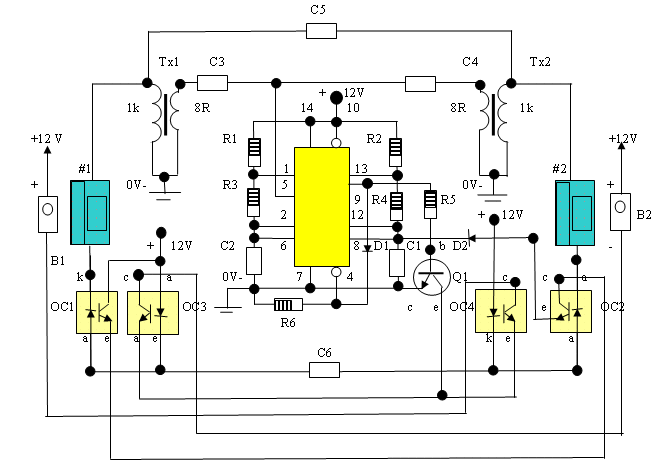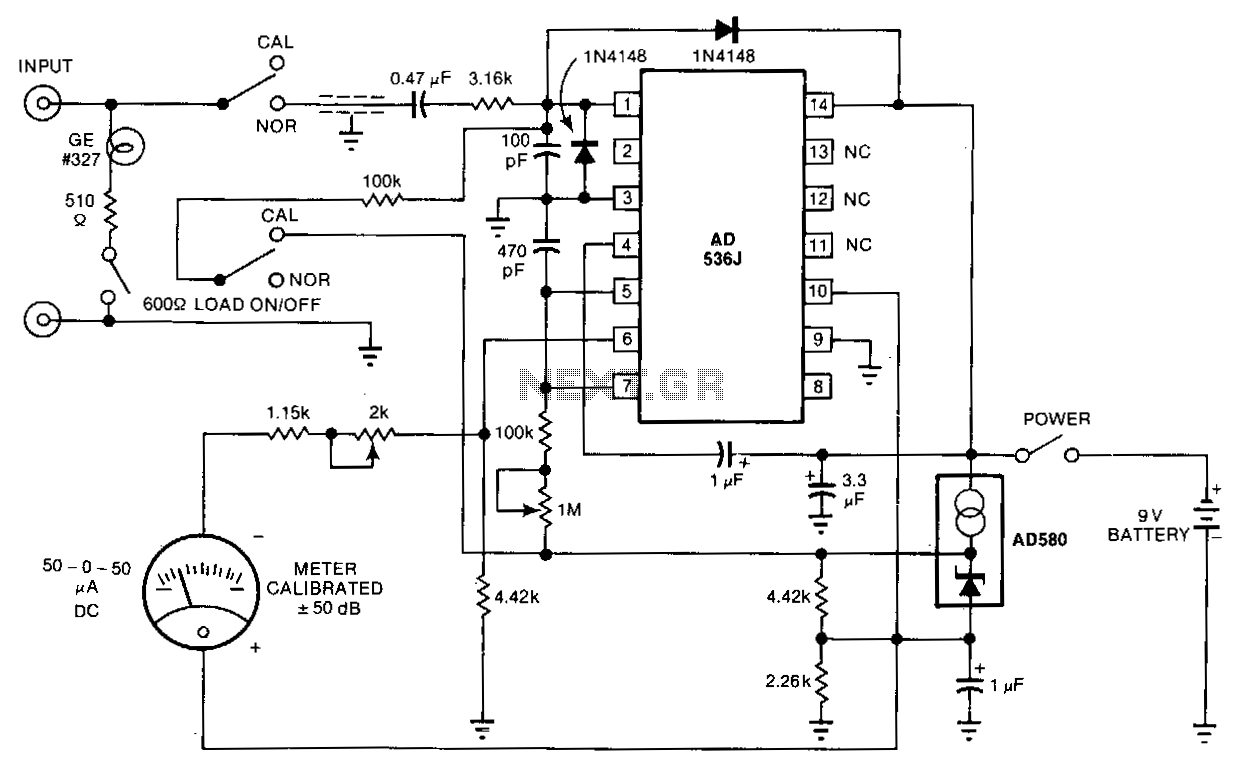
Telephone pickup preampliifer

This circuit utilizes the uA741 integrated circuit to capture voice signals from telephone lines without direct contact. By positioning a high-impedance magnetic core near a telephone device or along the telephone wires, the circuit can inductively pick up both sides of a conversation. A preamplifier, also based on the uA741, is employed to amplify these signals. The configuration functions as an inverting amplifier, with the gain determined by the feedback resistor R4. The operational amplifier provides sufficient gain to drive headphones, allowing the circuit to serve as a telephone bug.
The circuit is designed around the uA741 operational amplifier, which is a general-purpose op-amp known for its versatility in various applications. In this setup, the uA741 is configured as an inverting amplifier, which is a common configuration for signal amplification tasks. The gain of the amplifier is set by the resistor R4, which is connected in the feedback loop. The relationship between the input and output voltage is given by the formula:
\[ V_{out} = -\left(\frac{R_f}{R_{in}}\right) V_{in} \]
where \( R_f \) is the feedback resistor (R4 in this case) and \( R_{in} \) is the input resistor connected to the inverting input of the op-amp. By adjusting R4, the designer can control the gain to ensure that the output signal is strong enough to drive headphones or other audio output devices.
The high-impedance magnetic core acts as a sensor, capturing the electromagnetic fields generated by the telephone line. This allows the circuit to function without any physical connection to the telephone, making it useful for discreet audio monitoring applications. The circuit's passive components, including resistors and capacitors, should be selected to optimize performance and minimize noise, ensuring clear audio reproduction.
To enhance the circuit's effectiveness, careful consideration should be given to the placement of the magnetic core. Proximity to the telephone line or device is crucial for maximizing signal pickup. Additionally, the circuit may benefit from additional filtering stages to remove unwanted noise or interference, which can be achieved by incorporating capacitors in parallel with the resistors or using additional op-amp stages for further amplification and signal conditioning.
Overall, this simple yet effective circuit demonstrates the application of the uA741 op-amp in audio signal processing, particularly for non-invasive audio surveillance in telecommunication systems.Here is a simple circuit based on IC uA 741 that can be used to pickup voice from telephone lines without even contacting the line. If a high impedance magnetic core is placed near a telephone instrument or near one of the telephone wires, it picks up inductively both sides of the telephonic conversation without any electrical contact.
A preamplif ier based on IC uA741 is used to pickup these signals. The circuit is nothing but an inverting amplifier whose gain depends on the feedback resistance R4. The Op-Amp produces the necessary gain to drive the headphone. The circuit can be used as a telephone bug too. 🔗 External reference
The circuit is designed around the uA741 operational amplifier, which is a general-purpose op-amp known for its versatility in various applications. In this setup, the uA741 is configured as an inverting amplifier, which is a common configuration for signal amplification tasks. The gain of the amplifier is set by the resistor R4, which is connected in the feedback loop. The relationship between the input and output voltage is given by the formula:
\[ V_{out} = -\left(\frac{R_f}{R_{in}}\right) V_{in} \]
where \( R_f \) is the feedback resistor (R4 in this case) and \( R_{in} \) is the input resistor connected to the inverting input of the op-amp. By adjusting R4, the designer can control the gain to ensure that the output signal is strong enough to drive headphones or other audio output devices.
The high-impedance magnetic core acts as a sensor, capturing the electromagnetic fields generated by the telephone line. This allows the circuit to function without any physical connection to the telephone, making it useful for discreet audio monitoring applications. The circuit's passive components, including resistors and capacitors, should be selected to optimize performance and minimize noise, ensuring clear audio reproduction.
To enhance the circuit's effectiveness, careful consideration should be given to the placement of the magnetic core. Proximity to the telephone line or device is crucial for maximizing signal pickup. Additionally, the circuit may benefit from additional filtering stages to remove unwanted noise or interference, which can be achieved by incorporating capacitors in parallel with the resistors or using additional op-amp stages for further amplification and signal conditioning.
Overall, this simple yet effective circuit demonstrates the application of the uA741 op-amp in audio signal processing, particularly for non-invasive audio surveillance in telecommunication systems.Here is a simple circuit based on IC uA 741 that can be used to pickup voice from telephone lines without even contacting the line. If a high impedance magnetic core is placed near a telephone instrument or near one of the telephone wires, it picks up inductively both sides of the telephonic conversation without any electrical contact.
A preamplif ier based on IC uA741 is used to pickup these signals. The circuit is nothing but an inverting amplifier whose gain depends on the feedback resistance R4. The Op-Amp produces the necessary gain to drive the headphone. The circuit can be used as a telephone bug too. 🔗 External reference





